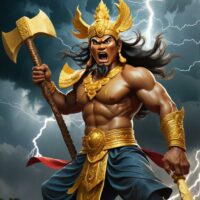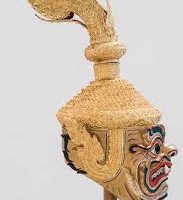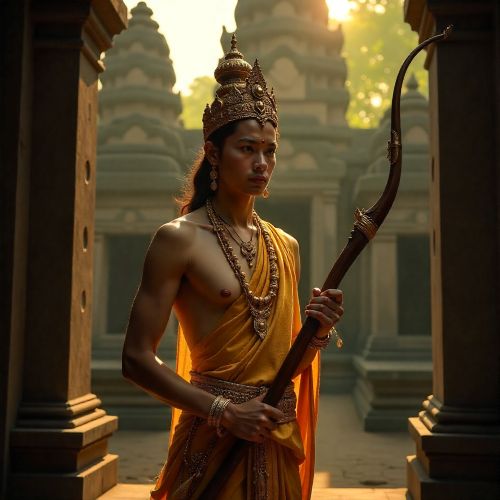Ream Eyso : The Thunder God
Listen
At a glance
| Description | |
|---|---|
| Origin | Cambodian Mythology |
| Classification | Gods |
| Family Members | N/A |
| Region | Cambodia |
| Associated With | Thunder |
Ream Eyso
Introduction
Ream Eyso (រាមអេសូ) is one of the most striking figures in Cambodian mythology, remembered as a powerful storm demon whose story explains the origins of thunder, lightning, and seasonal rains. His tale is most vividly portrayed in the classical dance drama Moni Mekhala Ream Eyso, a performance that has been passed down through centuries as both entertainment and sacred ritual. This myth embodies the eternal clash between opposing forces—Ream Eyso representing thunder and destructive storms, while the goddess Moni Mekhala symbolizes water, lightning, and the nourishing rains.
Unlike many mythological beings who live only in old manuscripts, Ream Eyso continues to thrive in Cambodia’s living traditions. His presence is seen in ritual dances, cultural festivals, and even in the way natural phenomena are explained within Khmer society. Through him, mythology, spirituality, and the natural world are woven into one seamless narrative.
Physical Traits
Ream Eyso is traditionally portrayed as a giant or ogre, embodying the raw power of storms. His theatrical representation in Cambodian dance gives him an imposing and exaggerated form. Dancers wear elaborate costumes featuring long embroidered sleeves, ornate banners, and a yaksha mask topped with a hamsa-tail crown. These elements highlight both his supernatural strength and his role as a fearsome antagonist.
One of his most recognizable features is the magical axe he carries, an object tied directly to his ability to create thunder. His movements in performance are often exaggerated with high steps and sweeping gestures, presenting him as both menacing and somewhat oafish. These characteristics align with traditional portrayals of giants in Khmer mythology—powerful yet flawed beings who serve as the counterbalance to divine forces of order and renewal.
Family
The myth of Ream Eyso is closely linked to his time as a disciple under the hermit Lok Ta Moni Eisei. Alongside him studied Moni Mekhala, goddess of the seas and lightning, and Voracchun, a princely figure tied to the Earth. Their teacher set a challenge to obtain a radiant crystal ball, a divine object symbolizing wisdom and cosmic balance.
Moni Mekhala’s intelligence and determination allowed her to win the crystal, sparking Ream Eyso’s jealousy. In his pursuit of the object, Ream Eyso clashed violently with his fellow student Voracchun, ultimately killing him. This act of rivalry set the stage for the eternal conflict between Ream Eyso and Moni Mekhala. Their struggle represents more than personal enmity—it reflects the interplay of natural forces, with storms and lightning locked in an endless dance that governs the rhythm of the seasons.
Other names
Ream Eyso’s name carries layers of meaning drawn from Cambodia’s blend of Hindu and indigenous Khmer traditions. In Sanskrit, elements of his name suggest a link to the divine title Īśvara, meaning “lord,” while “Ream” evokes associations with Rama, the celebrated hero of the Indian epic Ramayana. These linguistic roots show how Khmer mythology adapted Hindu deities and integrated them into its own cosmological framework.
He is also widely recognized through the sacred dance Robam Moni Mekhala Ream Eyso, considered the most important ritual dance in Cambodia. In some contexts, particularly in Khmer language usage, he is referred to as Rāmasūra. Each variation of his name emphasizes different aspects of his identity—as a storm demon, as a rival to Moni Mekhala, and as a figure tied to cosmic cycles.
Powers and Abilities
Ream Eyso’s defining power lies in his mastery over thunder and storms. Wielding his magical axe, he generates thunderclaps that shake the skies. His fiery rage is often linked to destructive winds and flashes of lightning, making him a symbol of chaos and natural upheaval.
The myth tells that his axe was one of three enchanted objects crafted by their teacher Lok Ta Moni Eisei, alongside Moni Mekhala’s crystal ball and Voracchun’s dagger. Together, these weapons of power represented the balance of earth, water, and storm. In the stories, every clash between Ream Eyso and Moni Mekhala produces the phenomena of thunder and lightning, which are followed by the life-giving rains.
Though feared for his destructive nature, Ream Eyso is not depicted as entirely evil. Instead, he represents the storm as an essential force of nature—frightening and uncontrollable, but also necessary for renewal. His role embodies the belief that destruction and creation are inseparably bound, with each season of storms bringing fertility and abundance to the land.
Modern Day Influence
The influence of Ream Eyso endures in Cambodian culture, particularly through the sacred dance Moni Mekhala Ream Eyso. Performed annually during the buong suong ceremony at the onset of the rainy season, this dance not only entertains but also serves as a ritual invocation for rain and agricultural prosperity. Audiences see the clash of Ream Eyso’s thunderous strikes and Moni Mekhala’s dazzling flashes of light, dramatizing the cosmic battle that sustains life.
Even beyond ritual, his myth resonates with Cambodians as a way of interpreting the weather. The rumble of thunder is said to be the sound of Ream Eyso’s axe, while flashes of lightning are the sparkling brilliance of Moni Mekhala’s crystal ball. This natural symbolism ensures the myth remains relevant in daily life, especially for agricultural communities whose livelihoods depend on seasonal rains.
In modern times, the story has been reimagined through ballets, school teachings, and artistic retellings. His image appears in masks, murals, and cultural festivals, cementing his status as a guardian of tradition. Moreover, his rivalry with Moni Mekhala is sometimes reinterpreted through a contemporary lens: while he embodies brute force and chaos, she represents intelligence and resilience. Their dynamic is seen as a symbolic reminder of the triumph of wisdom and balance over unchecked aggression.
Ream Eyso also appears in newer cultural expressions, from literature to visual arts and even digital storytelling, where Cambodian creators reinterpret traditional myths for younger audiences. These modern adaptations ensure that his legacy is not just a relic of the past but a living, evolving narrative that continues to inspire both reverence and creativity.
Related Images
Source
Bizot, F. (2004). The Gate. Vintage.
Chandler, D. P. (2008). A History of Cambodia (4th ed.). Westview Press.
Jacobsen, T. (2008). Lost Goddesses: The Denial of Female Power in Cambodian History. NIAS Press.
Sam, A. (1998). Cambodian Dance: Celebration of the Gods. Weatherhill.
UNESCO. (n.d.). Robam Moni Mekhala Ream Eyso. Retrieved from https://ich.unesco.org/en/RL/robam-moni-mekhala-ream-eyso-00108
Khmer Mythology Archive. (n.d.). Ream Eyso and Moni Mekhala. Retrieved from https://www.khmermythology.org/ream-eyso-and-moni-mekhala
Royal Ballet of Cambodia. (n.d.). Mythological Characters. Retrieved from https://www.royalballetcambodia.org/mythological-characters
Frequently Asked Questions
What is lorem Ipsum?
I am text block. Click edit button to change this text. Lorem ipsum dolor sit amet, consectetur adipiscing elit. Ut elit tellus, luctus nec ullamcorper mattis, pulvinar dapibus leo.
What is lorem Ipsum?
I am text block. Click edit button to change this text. Lorem ipsum dolor sit amet, consectetur adipiscing elit. Ut elit tellus, luctus nec ullamcorper mattis, pulvinar dapibus leo.
What is lorem Ipsum?
I am text block. Click edit button to change this text. Lorem ipsum dolor sit amet, consectetur adipiscing elit. Ut elit tellus, luctus nec ullamcorper mattis, pulvinar dapibus leo.
What is lorem Ipsum?
I am text block. Click edit button to change this text. Lorem ipsum dolor sit amet, consectetur adipiscing elit. Ut elit tellus, luctus nec ullamcorper mattis, pulvinar dapibus leo.
What is lorem Ipsum?
I am text block. Click edit button to change this text. Lorem ipsum dolor sit amet, consectetur adipiscing elit. Ut elit tellus, luctus nec ullamcorper mattis, pulvinar dapibus leo.











